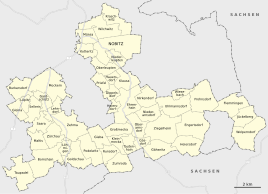Gardschütz
|
Gardschütz
community Nobitz
Coordinates: 50 ° 56 ′ 37 ″ N , 12 ° 25 ′ 26 ″ E
|
|
|---|---|
| Height : | 186–194 m above sea level NN |
| Area : | 1.2 km² |
| Residents : | 5 |
| Population density : | 4 inhabitants / km² |
| Incorporation : | July 1, 1950 |
| Incorporated into: | Lehndorf |
| Postal code : | 04603 |
| Area code : | 03447 |
|
Location of Gardschütz in the unified municipality of Nobitz
|
|
|
Gardschützer Mill
|
|
Gardschütz is a district of Nobitz in the Altenburger Land district in Thuringia .
location
Gardschütz is located in the Pleißetal six kilometers south of Altenburg and north of Saara on the federal highway 93 . In addition, the Leipzig – Hof railway line with a train station touches the place .
The district is also located on the edge of the Leipzig lowland bay in the Altenburg-Zeitz loess hill country. The place consists of two spatially separated parts. On the one hand, today's place with the mill, three houses and four agricultural buildings and, on the other hand, part of the agglomeration of Lehndorf , the northeastern part of Lehndorf around the train station with the sawmill and the listed granary is still part of the Gardschütz district. Until 2013, the northern part of the Lehndorf settlement area belonged to the Gardschütz district, but was assigned to Lehndorf in that year.
history
The place was first mentioned in a document in 1347. However, the village goes from 1378. Gardschütz is a Sorbian foundation. Probably between 1270 and 1280 the Grünhain monastery received the area around Gardschütz as a fief. The farmers in the former Slavic hamlet could not withstand the pressure of the monks of the neighboring monastery, so that the Gardschütz monastery courtyard could take over the land. The monastery property grew bigger and bigger, so that its rule extended to the places Göhren , Illsitz , Goldschau , Oberarnsdorf , Remsa , Zechau and Zschaiga . In 1535 the monastery was secularized . The monastery property in Gardschütz was converted into a manor. In 1544 the land fell to farmers in Gardschütz, Lehndorf and Heiligenleichnam .
Gardschütz belonged to the Wettin office of Altenburg , which was under the sovereignty of the following Ernestine duchies from the 16th century due to several divisions in the course of its existence : Duchy of Saxony (1554 to 1572), Duchy of Saxony-Weimar (1572 to 1603), Duchy of Saxony-Altenburg (1603 to 1672), Duchy of Saxony-Gotha-Altenburg (1672 to 1826). When the Ernestine duchies were reorganized in 1826, the place came back to the duchy of Saxony-Altenburg. After the administrative reform in the duchy, it belonged to the eastern district (until 1900) and to the Altenburg district office (from 1900). From 1918 the village belonged to the Free State of Saxony-Altenburg , which was added to the State of Thuringia in 1920. In 1922 it came to the district of Altenburg .
On July 1, 1950, Gardschütz was incorporated into Lehndorf. During the second district reform in the GDR in 1952, the existing states were dissolved and the districts were redesigned. Thus Gardschütz came as the district of Lehndorf with the district Altenburg to the district of Leipzig , which since 1990 belonged to the district Altenburg Thuringia and opened in 1994 Altenburger in the district of the country. With the rise of the community Lehndorf in the unified community Saara , Gardschütz became a district of this community on January 1, 1996, until it came to Nobitz on December 31, 2012. Today about 5 people live in the district.
Attractions
Gardschütz is known for its mill, which has been in family ownership again since 1990 and is still in operation. It was nationalized in 1972 and merged with Saara Mills in 1977. The mill works with a turbine that is driven by the Pleiße and therefore only needs about half of the electrical energy. It also houses a restaurant. Next to the mill, a riveted iron truss footbridge leads over the Pleiße, it is a listed building. The bridge over the railway line to the Kornhaus near Lehndorf, which had been closed for years, was demolished in 2014 as the railway line was expanded.
Motor vehicle traffic
An automatic counting station of the Federal Highway Research Institute , which determines the volume of traffic , has been located on Bundesstrasse 93, which runs past the site, since 1997 . It has the counting station number 4474. The DTV (average daily traffic volume) was 7767 vehicles per day in 2014, with a heavy traffic share of 9.8%. This means that the volume of traffic has been largely stable since 2009.
Web links
Individual evidence
- ↑ a b c Gardschütz on the website of the municipality of Nobitz.Retrieved on January 21, 2016
- ^ Wolfgang Kahl : First mention of Thuringian towns and villages. A manual. Rockstuhl Verlag, Bad Langensalza, 2010, ISBN 978-3-86777-202-0 , p. 83
- ^ The Altenburg Office in the book "Geography for all Stands", from p. 201
- ^ The locations of the Altenburg district from p.83
- ↑ The eastern district of the Duchy of Saxony-Altenburg in the municipal directory 1900
- ^ The Altenburg district office in the municipality register 1900
- ↑ Gardschütz on gov.genealogy.net
- ↑ Website of the mill.Retrieved January 21, 2016
- ↑ Counting point 4474 on the BASt website.Retrieved on January 21, 2016

